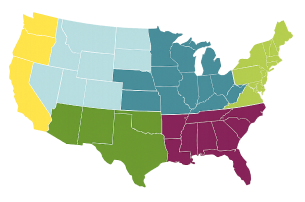Idaho Native Plants, State Flower & State Bird
Posted By American Meadows Content Team on Sep 27, 2012 · Revised on Oct 26, 2025

Knowing your location helps us recommend plants that will thrive in your climate, based on your Growing Zone.
Posted By American Meadows Content Team on Sep 27, 2012 · Revised on Oct 26, 2025
Native plants are adaptable, low-maintenance, and beautiful. They are the best choice for habitat-friendly gardens and thriving ecosystems. Find top picks for native plants in your state - and learn about your state bird and state flowers!
Follow Along With More Of Our Guides
Hello native plant enthusiasts! In the list below, you will find popular native plants and wildflower seeds, available from American Meadows, that have a native distribution in your state. You’ll also find information about your state bird, state flower, and state wildflower!
Grow our Native West Wildflower Seed Mix.
Black Eyed Susan or Gloriosa Daisy (Rudbeckia hirta)
Yellow Prairie Coneflower (Ratibida columnifera)
Swamp Milkweed (Asclepias incarnata)
Firewheel (Gaillardia pulchella)
Blanket Flower (Gaillardia aristata)
Wild Strawberry (Fragaria virginiana)
Plains Coreopsis (Coreopsis tinctoria)
Wild Bergamot (Monarda fistulosa)
Little Bluestem (Schizachyrium scoparium)
Tufted Hair Grass (Deschampsia cespitosa)

Mountain Bluebird ~ Sialia currucoides
The Mountain Bluebird sings its seldom-heard but sweet warble in high meadows at altitudes of up to 10,000 feet. It may venture as far north as central Alaska and is sometimes called the Arctic Bluebird. Nesting in tree holes and bird boxes, this species incubates two sets of five or six blue eggs in a season.
Syringa ~ Philadelphia lewisii
No state flower has as many names as Idaho's, and none raises as many questions. This confusion over the flower's proper name is the fault of the old herbalists who united jasmine, mock orange, and lilac under once classification, Syringa. The kind of Syringa chosen as Idaho's state flower grows to twelve feet in height. In early summer it is covered with masses of fragrant white flowers. Glistening petals surround numerous bright yellow stamens. After the flower's four petals fall, the green seed capsule, set in a cup made by four sepals, continues to decorate the shrub. In late summer this seed capsule ripens and releases the seeds.
From The Wildflowers of the 50 States U.S. stamps issues July 24, 1992:

